



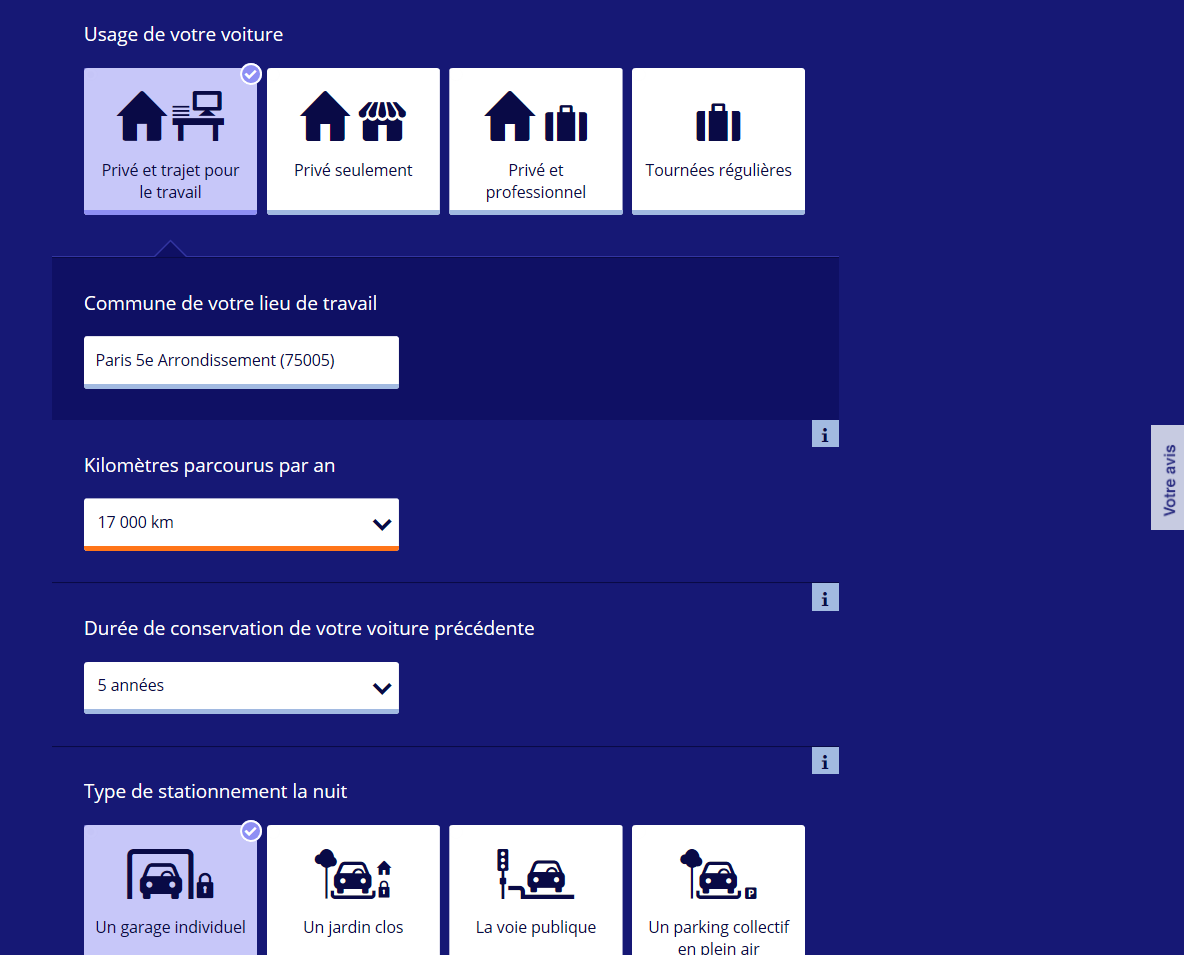
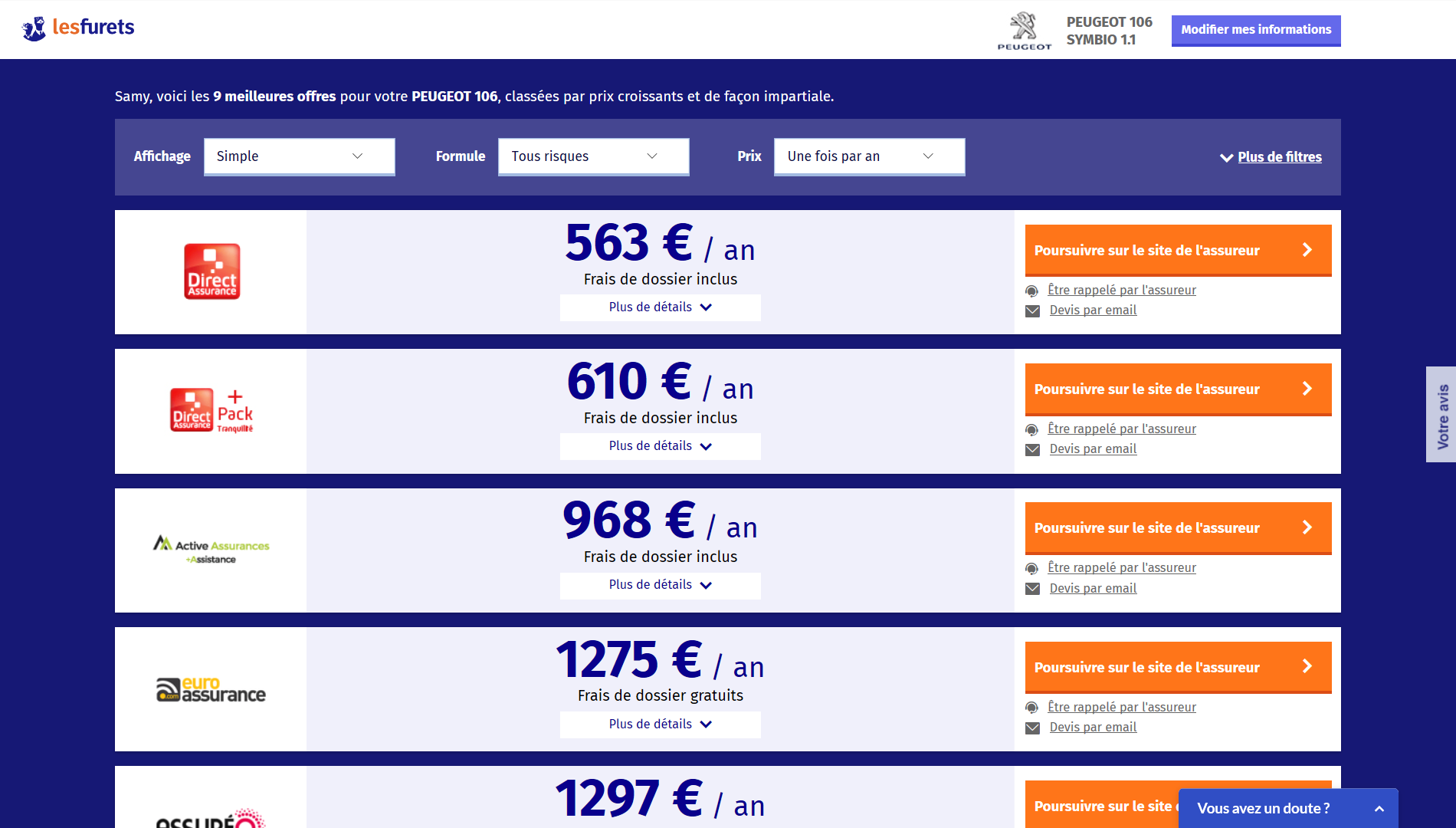


We have 71 live insurers, on 5 products, each with business validation rules,
that filter prospects based on their profile
Hierarchy of 492 legacy classes, no governance or auditability
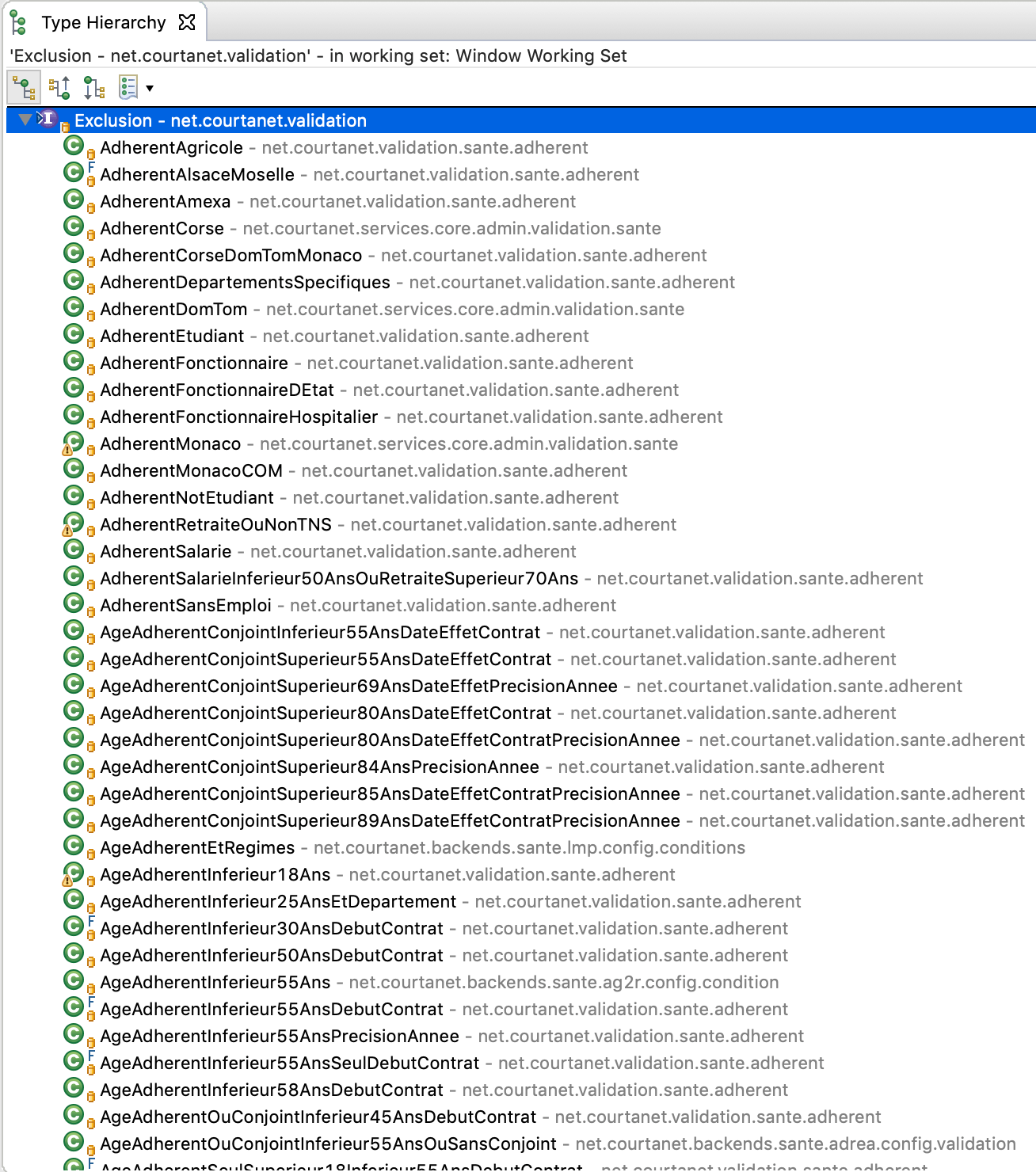
Insurer exclusions based on object model (legacy code)
public void check(FieldContext context, FormuleMoto formule, Conducteur conducteur,
Vehicule vehicule, Void unused, Besoins besoins,
Set<EAbTestingScenario> scenarios)
throws ExclusionException {
if (besoins == null) {
return;
}
if (besoins.getDateDebutContrat() == null) {
return;
}
if (!DateHelper.isAfter(besoins.getDateDebutContrat(),
DateHelper.ajouteJoursADate(DateHelper.getToday(), NBR_JOURS),
DateHelper.EPrecision.jour)) {
throw new ExclusionException(DATE_EFFET_PLUS_60_JOURS);
}
}Same rule, more fluent:
public ExclusionRule exclusionRule() {
return DOOV.when(dateContrat().after(todayPlusDays(60)))
.excludeFormules(F1, F2, F3)
.withMessage(DATE_EFFET_PLUS_60_JOURS)
.exclusionRule();
}Java is verbose, but you can reduce the noise and write code like natural language with a fluent API
// JUnit API
assertEquals(9, fellowshipOfTheRing.size());
assertTrue(fellowshipOfTheRing.contains(frodo, sam));
assertFalse(fellowshipOfTheRing.contains(sauron));
// AssertJ API (fluent)
assertThat(fellowshipOfTheRing).hasSize(9)
.contains(frodo, sam)
.doesNotContain(sauron);New elements in Java 8 makes it easier to write a fluent API
// java.util.function (io.doov.core.dsl.impl.LogicalBinaryCondition)
left.predicate().and(right.predicate()).test(model, context)
// java.util.stream (io.doov.core.dsl.impl.LogicalNaryCondition)
steps.stream().anyMatch(s -> s.predicate().test(model, context))
// lambda and method reference (io.doov.core.dsl.impl.NumericCondition)
predicate(greaterThanMetadata(field, value),
(model, context) -> Optional.ofNullable(value),
(l, r) -> greaterThanFunction().apply(l, r));Many popular libraries propose fluent APIs like
jOOQ, AssertJ, Apache Spark, etc.
Dataset<Row> averagePrice = prices
.filter(value.<String>getAs("insurer")
.equals("COOL insurer"))
.groupBy("product")
.agg(avg("price").as("average"))
.orderBy(desc("average"));"A domain-specific language (DSL) is a computer language specialized to a particular application domain. This is in contrast to a general-purpose language (GPL), which is broadly applicable across domains"
Domain Object Oriented Validation
dOOv is a fluent API for typesafe domain model validation
We developed a typed, null-safe, two way mapping framework
from key value to model.
object
public class Account {
@Path(field = SampleFieldId.LOGIN,
readable = "account login")
private String login;
@Path(field = SampleFieldId.PASSWD,
readable = "account password")
private String password;
}dictionary
Account account = new Account();
account.setLogin("alex");
SampleModel model = new SampleModel();
model.setAccount(account);
SampleModelWrapper wrapper
= new SampleModelWrapper(model);
wrapper.get(SampleFieldId.LOGIN); // alex
wrapper.set(SampleFieldId.LOGIN, "bob");
wrapper.get(SampleFieldId.LOGIN); // bob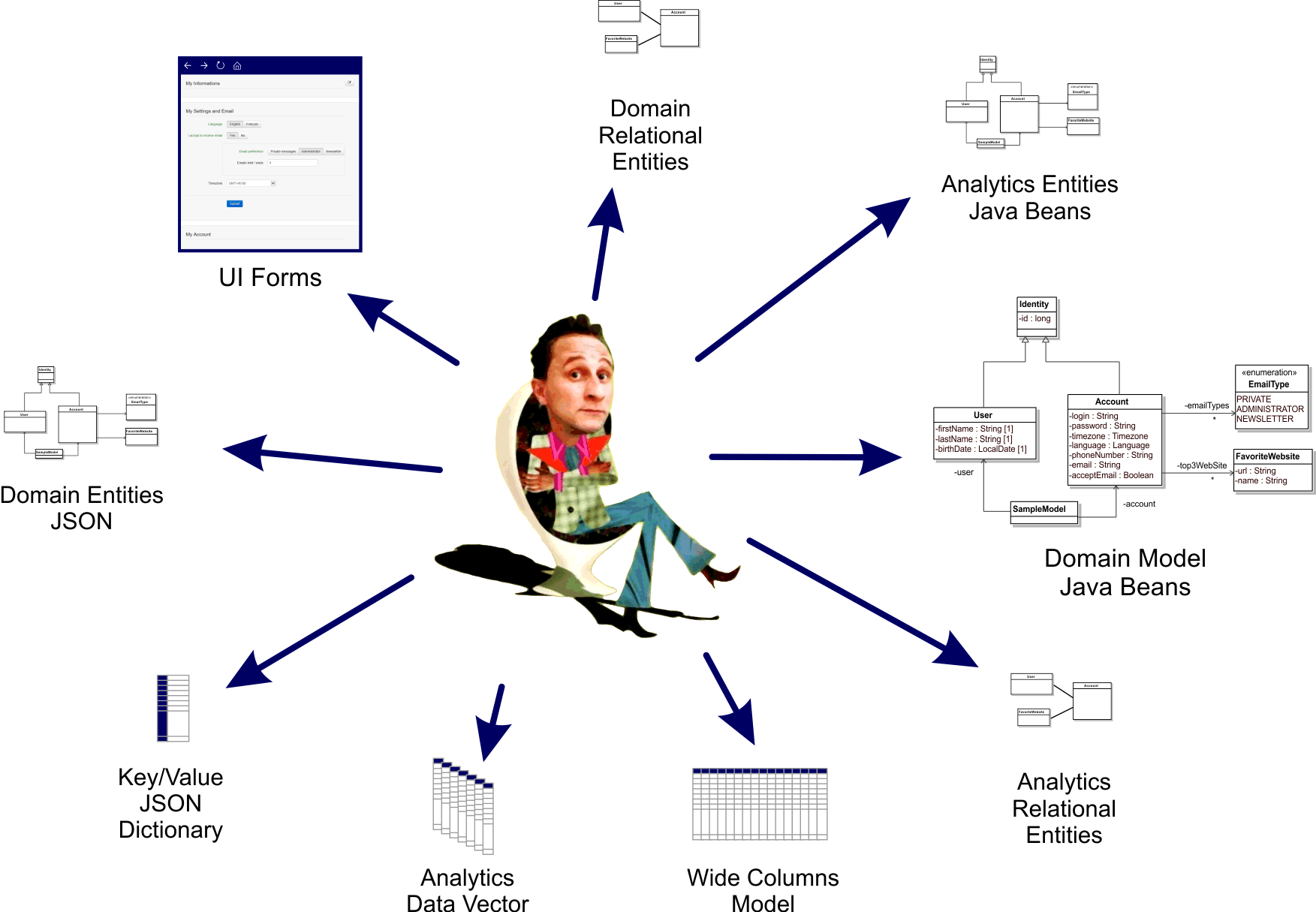
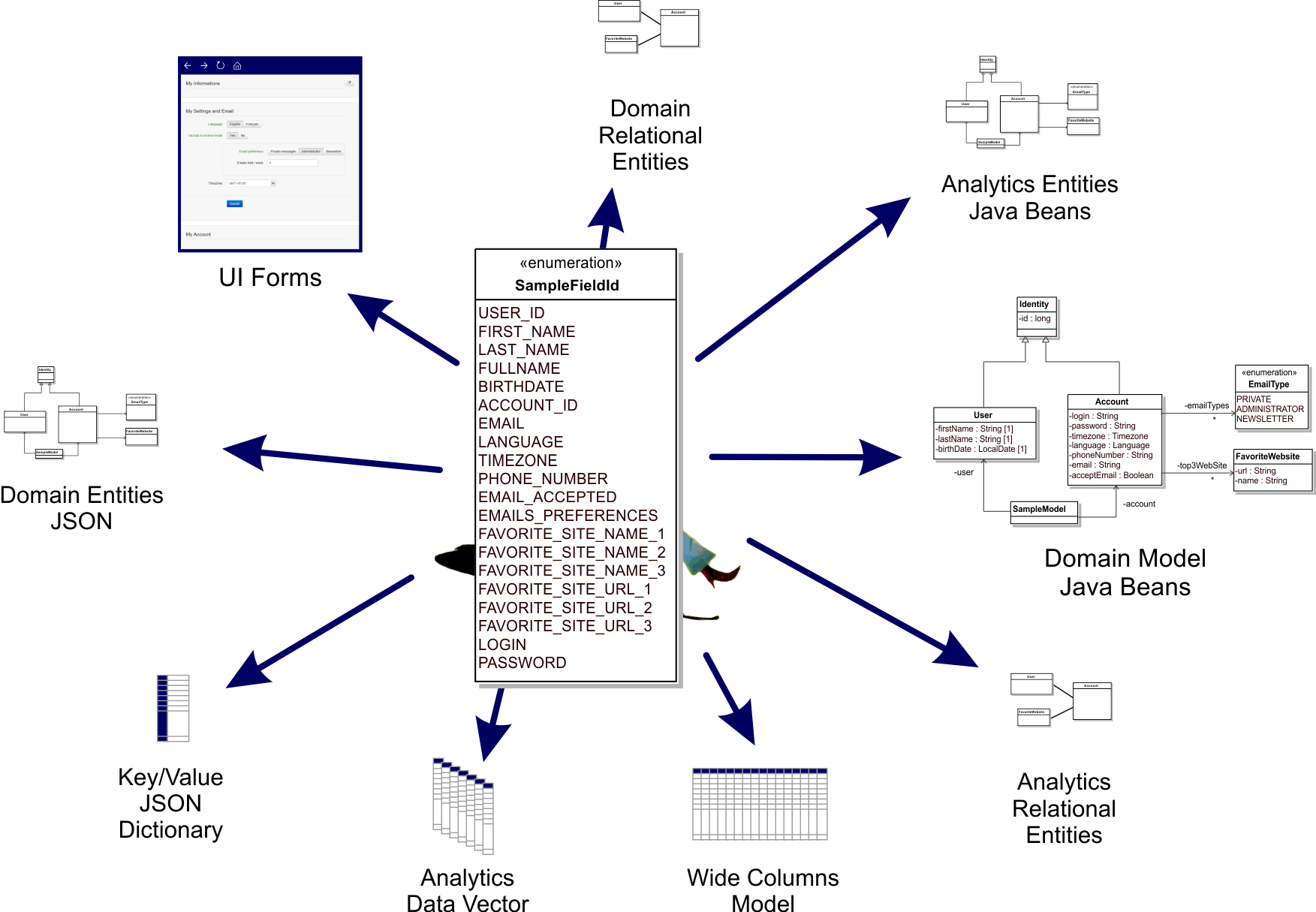
key model
class Model {
User user;
}
class User {
@Path(field = EMAIL)
String email;
}
enum ModelFieldId {
EMAIL;
}code generate
class ModelFieldIdInfo {
FieldInfo userEmail();
}
class ModelWrapper {
...
}write rules
class Validations {
ValidationRule email =
DOOV.when(userEmail().eq(...))
.validate()
.register(REGISTRY_DEFAULT);
}wrap model
User user = new User();
user.setEmail("e@mail.com");
Model model = new Model();
model.setUser(user);
ModelWrapper wrap
= new ModelWrapper(model);execute
REGISTRY_DEFAULT.stream()
.map(rule -> rule.executeOn(wrap));public class Account extends Identity {
@SamplePath(field = SampleFieldId.TIMEZONE,
readable = "account timezone")
private Timezone timezone;
@SamplePath(field = SampleFieldId.PHONE_NUMBER,
readable = "account phone number")
private String phoneNumber;
@SamplePath(field = SampleFieldId.EMAIL,
readable = "account email")
private String email;
@SamplePath(field = SampleFieldId.EMAIL_ACCEPTED,
readable = "account email accepted")
private boolean acceptEmail;
@SamplePath(field = SampleFieldId.EMAILS_PREFERENCES,
readable = "account préférences mail")
private Collection<EmailType> emailTypes = new HashSet<>();
}public static boolean validateAccount(User user, Account account, Configuration config) {
if (config == null) {
return false;
}
if (user == null || user.getBirthDate() == null) {
return false;
}
if (account == null || account.getCountry() == null || account.getPhoneNumber() == null) {
return false;
}
if (YEARS.between(user.getBirthDate(), LocalDate.now()) >= 18
&& account.getEmail().length() <= config.getMaxEmailSize()
&& account.getCountry().equals(Country.FR)
&& account.getPhoneNumber().startsWith("+33")) {
return true;
}
return false;
}ValidationRule userAccount = DOOV
// Entry point is when
.when(userBirthdate().ageAt(today()).greaterOrEquals(18)
.and(accountEmail().length().lesserOrEquals(configurationMaxEmailSize()))
.and(accountCountry().eq(Country.FR))
.and(accountPhoneNumber().startsWith("+33")))
// Terminal operation is validate
.validate()
// Optional: add message
.withMessage("user account")
// Optional: add to registry
.registerOn(REGISTRY_DEFAULT);@Test
public void should_user_account_validates() {
// Condition assert
assertThat(accountEmail().isNotNull()).validates(wrapper);
// Rule assert
assertThat(RulesConference.userAccount).validates(wrapper);
// Result assert
Result result = RulesConference.userAccount.executeOn(wrapper);
assertThat(result).isTrue();
}The entry point is DOOV#when(StepCondition) and the operation StepWhen#validate returns the validation rule
DOOV.when(accountEmail().matches("\\w+[@]\\w+\\.com")
.or(accountEmail().matches("\\w+[@]\\w+\\.fr")))
.validate()
.withMessage("email finishes with .com or .fr");This is lazy
A natural language version of the rule is available with ValidationRule#readable.
This makes auditability and compliance possible.
System.out.println(EMAIL_VALID.readable());
> When (email matches '\w+[@]\w+\.com' or email matches '\w+[@]\w+\.fr')
> validate with message "email finishes with .com or .fr"You can add the rule in one or many registry with ValidationRule#registerOn(Registry)
This makes governance possible.
DOOV.when(accountEmail().matches("\\w+[@]\\w+\\.com")
.or(accountEmail().matches("\\w+[@]\\w+\\.fr")))
.validate()
.registerOn(REGISTRY_ACCOUNT);The terminal operation ValidationRule#executeOn(FieldModel)
executes the rule
REGISTRY_ACCOUNT.stream()
.map(rule -> rule.executeOn(model))
.filter(Result::isInvalid)
.map(Result::message)
.collect(toList());The available operations depend on the field type, and the arguments are type safe and validated by the compiler
DOOV.when(userAccountCreation().after(LocalDate.of(2000, 01, 01))).validate();
// ^^^^^
// only for date fieldDOOV.when(userAccountCreation().after(LocalDate.of(2000, 01, 01))).validate();
// ^^^^^^^^^^^^^^^^^^^ ^^^^^^^^^^^^^^^^^^^^^^^^^^^
// date field is type safe hereMakes readable text generation possible:
we can output a multi-language rules catalog
in multiple formats (text, markdown, HTML, etc.)
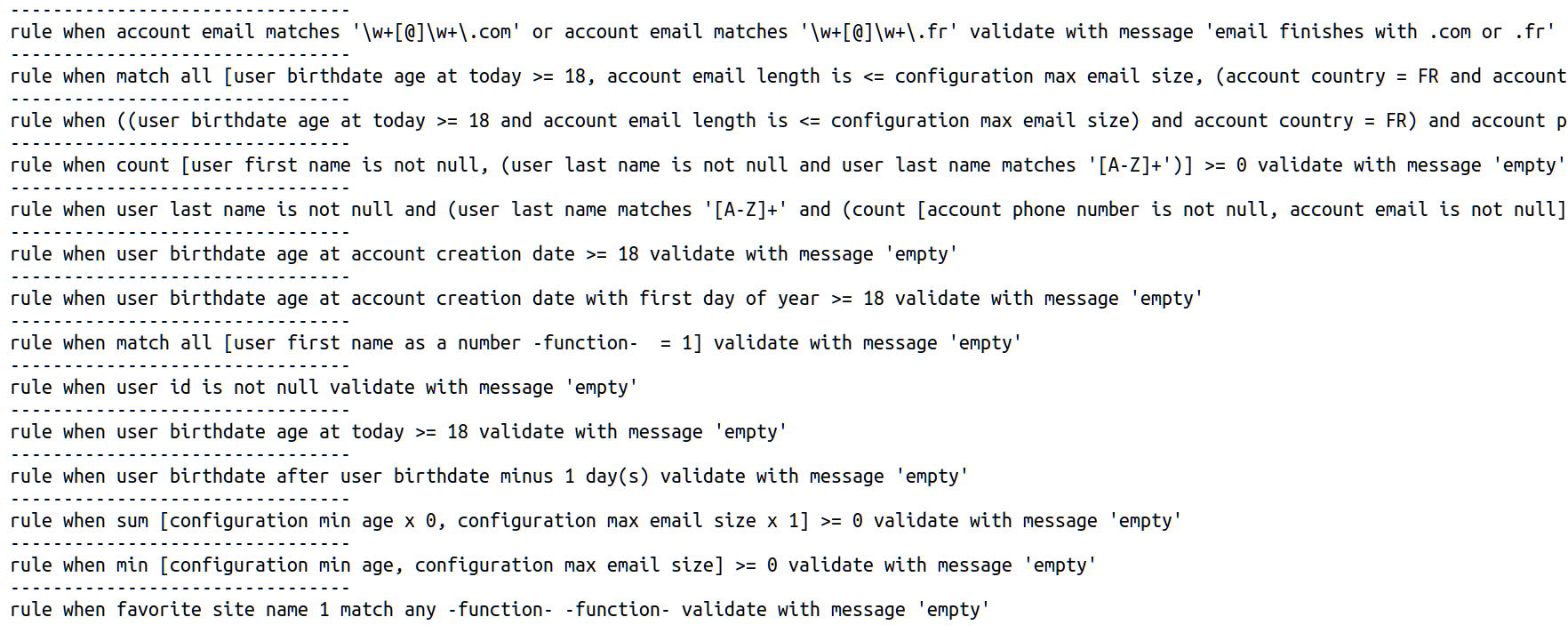
We generate a HTML validation rules catalog,
grouped by insurers and by insurance product
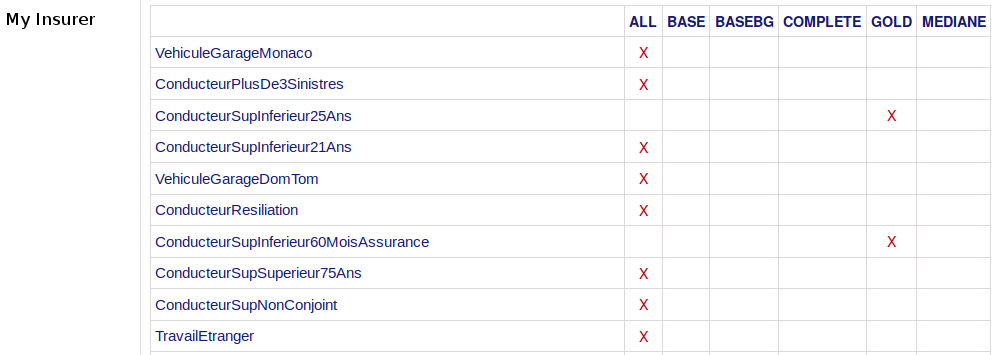
The syntax tree makes it possible to generate the rule as text. Notice how the elements from the tree are tokenized (operator, fields, etc.)

Also, the syntax tree makes it possible to see all the rules that applies for a specific field, for example the driver's date of birth.
During execution, each node of the AST captures context value and predicate result. We know at runtime which node failed, and why.

We make daily statistics that helps us shape the business,
by removing or tweaking rules as needed
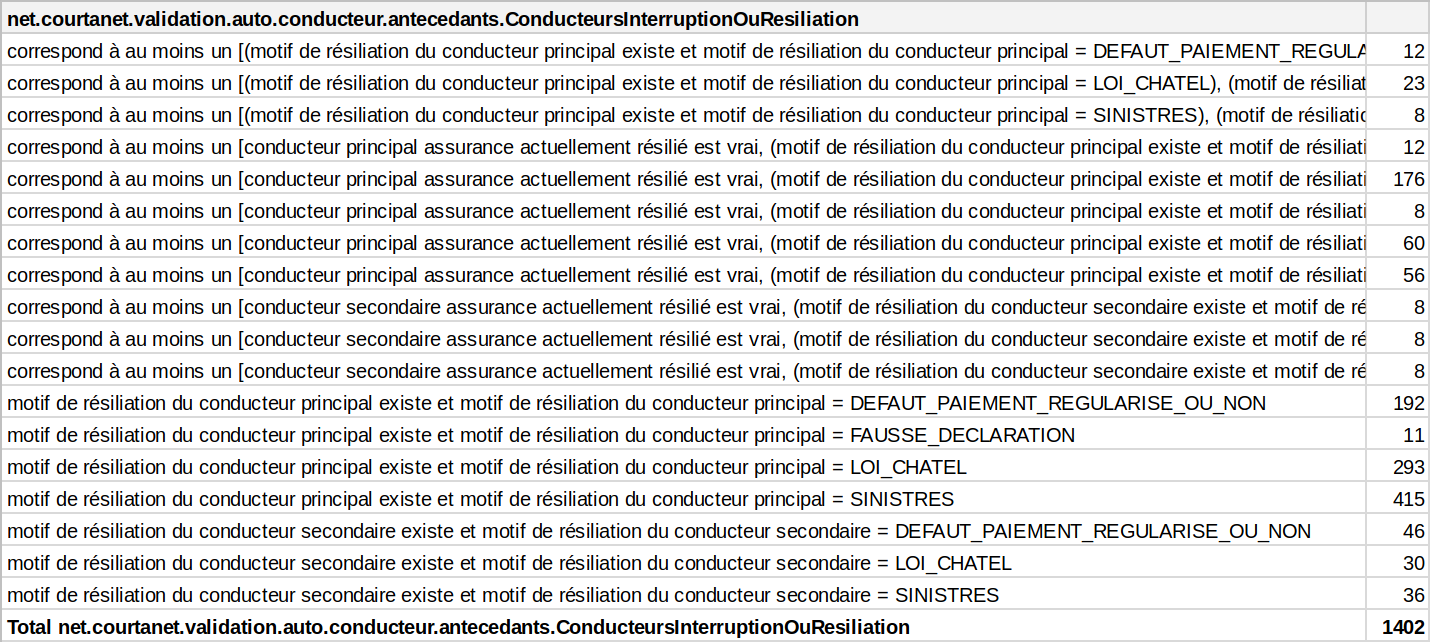
We also rewrite the execution rules by simplifying the predicate tree, to show the minimal predicate that fails. This is a complex problem we are currently working on.

By default, predicate evaluation in dOOv behaves like Java: it short-circuits. This can be disabled to execute all nodes, even if they don't impact the end result.
We use JMH to check the performance of the DSL
Benchmark Mode Samples Mean Mean error Units
o.m.BenchmarkOldRule.valid_email thrpt 25 1860.553 42.269 ops/ms
o.m.BenchmarkRule.valid_email thrpt 25 1733.465 18.461 ops/msPerformance of the DSL and POJO code are very close
We tested the performance of dOOv against the Bean Validation benchmark
and dOOv is faster in every category (hint: reflection API)
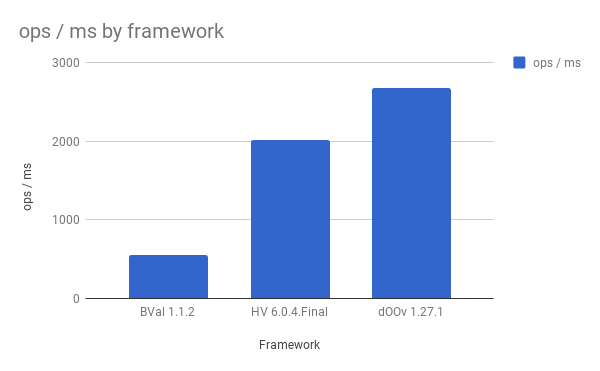
Bean Validation rules are not strongly typed since it's annotation based. This code will fail at compile time, but your IDE won't be able to tell you why.
public class Account {
@NotNull @Email
private Email email;
}Because Bean Validation constraints are based on field annotation, cross validation between fields are only available through the extension mechanism.
public class Account {
@Pattern(regexp = "(FR)|(UK)")
private String country;
@Pattern(regexp = "???")
private String phoneNumber;
}Bean Validation rules are not written with a natural language syntax and does not provide a syntax tree
@Size(min = 10, max = 200,
message = "About Me must be between 10 and 200 characters")
private String aboutMe;userAboutMe().length().between(10, 200).validate().readable()
> When user about me length is between 10 and 200, validate with message...
dOOv is harder to debug than bare metal code
dOOv cannot handle lists of arbitrary size,
meaning your model needs to be bounded
(there are workarounds)
We migrated our 492 business rules to dOOv,
we now have compliance, auditability, governance, clarity
(and more!)
Next step is extending the DSL to create an object to object mapping framework, Domain Object Oriented Mapping (dOOm). It will feature the same AST to text and statistics functionnalities.
DOOV.map(userEmail().to(insurerEmail())
.map(userFirstName(), userLastName())
.using(StringJoiner)
.to(insurerFullName())
.when(userCountry().eq(FR))
.map(userPhone().to(insurerPhone()))Stay tuned for the next versions!